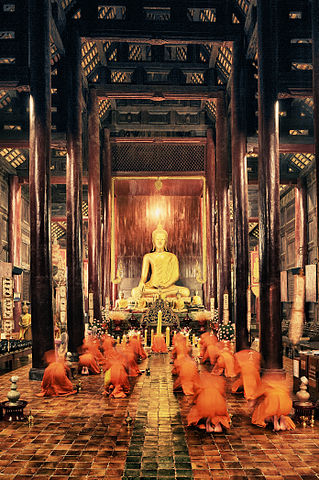Theravada Buddhism
The Buddhist Theravada remained as a line after the secession of the Mahayana at the second buddhist Council.
It is today the Buddhist religion prevalent in Burma (Myanmar) and Thailand, but is also common in Sri Lanka, Cambodia, Laos and Vietnam. It comes from the lineage of tradition of the bhikkshuni ordination and claims to transmit the original teachings of the Buddha (Theravāda: Teaching of the elderly of the orders), A claim to that already regarding to the twisted contents of the Tipitaka considerable doubts exist.
The goal of the Theravāda is officially the preservation of the original teachings of the Tipitaka with the characteristics:
- Completely truthful doctrine (svakkhata dhamma)
- For each testable teaching (ehi passika)
- Timelessly effective teaching (akalika)
- Realistic visible teaching (sanditthika]
- Doctrineleading to liberation (opanayika)
The many tantric Bodhisattvas are unknown here, just as the meditations differ completely from the practices of the Mahayana and of the tibetan tantra.
In the first Theravada Council of 1788 in Bangkok the Pali texts as the first complete print edition in Thai script in 39 volumes came into beeing.
The Pali-Canon (Tipitaka) consists of several books :
- Vinaya Pitaka, basket of religious orders
- Sutta Pitaka, The basket of the tenets (with the 31 levels of existence)
- Abhidhamma Pitaka, The basket of higher doctrine
The objectives are
- Nibbana (sanskrit: Nirvana): quenching )
- Bodhi (awakening) : Savaka-Bodhi, Pacceka-Bodhi and finally Samma-Sambodhi
In the Pali canon four levels of enlightenment are distinguished:
- streamentry (Pali: sotapatti)
- Once recurrence (Pali: ekadagami)
- Not return (Pali: anagami)
- Arhatship (Pali: arahatta)
The multitude of Bodhisattvas and Buddhas as in Mahayana and in Vajrayana is here unknown, who are regarded as apocryphal.
A summary from the point of view of Theravada are the 37 necessary things for enlightenment - enumerated in the Mahāsakuludāyi - Sutta. The Diamond - Sutra denies these in chapter 13.
It must also be said that the original teachings of the buddha were very simple, and the Tipitaka is a compilation with influences of hinduism and of poets. Already the life of the buddha as described in the Mahavastu is more a symbolic and not really understood. The curriculum vitae as in the Buddhavamsa of the Sutta Pitika contains just a stories.
Buddhaghosa statet at his time that he doesnt really understand the path and is waiting for Maitreya to clear the path.
The Abhidhamma is here often looked at as a teaching which the buddha spread 40 days after his enlightenment.
The Sarvāstivāda Abhidharma postulated that the Buddha's body born from his mother (
Also a manomaya kāya is known, which was sometimes interpreted as the enlightenment body of a buddha. The esoteric bodies of the yogasystems are here not defined.
The dharmakaya-body in the Mahayana-trikaya was a bit different, and the Tathagatas body was looked at as undestructable, infinite, pure, formless and free of sensations.
* Buddhism: The early Buddhist schools and doctrinal history ..., Vol 2, Paul Williams, S. 120
* Religion Health & Suffering, Porter, S. 151
== Kosmology ==
The cosmology of the Theravada describes 31 planes[2] in which the rebirth takes place.
The order of the plains is enumerated in various parts of the Sutta Pitaka (for example, in Saleyyaka Sutta of Majjhima Nikaya, Anguttara Nikaya, Samyutta Nikaya, Digha Nikaya, Khuddaka Nikaya).
In various sutras of Anguttara Nikaya, the Buddha describes the reasons for the rebirth in these planes.
== Triloka ==
In Buddhism, the concept of three worlds (triloka) refers to three levels of rebirth:
- Kāmaloka(S. kāma-dhātu): World of desire, typical basic desires and thus crowded of hell beings, pretas, animals, spirits, people and lower semi-gods
- Rūpaloka: World of form, quite free from low desires and populated by Jhana gods. Reincarnation place for advanced practitioners in janish or meditative absorption.
- Arūpaloka(S. ārupa-dhatu): World of formlessness. Non-physical reality of the 4 heavens. Here the practitioners of the 4 formless steps are reborn
== Sadhana ==
In addition to the realization of the doctrine, the Vipassanā meditation and the Samatha [5] are part of the practice. In addition, breath-meditations are common. An essental practice is also the Jhana - Meditation with its cosmic aspects of emptiness.
== Literatur ==
- David Kalupahana, Causality: The Central Philosophy of Buddhism. The University Press of Hawaii, 1975
- Trimala
- Buddha sutras
- Theravada Text & Teachings
- Essentials of buddhism
- Taisho Tripitaka Index
- Manual of insight, Steve Armstrong - Mahasi Sayadaw, Vipassana Metta Foundation Translation Committee, Wisdom Publications, 2016, ISBN-10: 1614292779 ISBN-13: 978-1614292777
- Manual of Abidhamma, Narada Maha Thera
== References ==
- https://sites.google.com/site/mudithacom/universe/solar_system_en
- http://web.archive.org/web/20081006103952/http://www.yellowrobe.com/samatha_meditation_method_in_brief
== Weblinks ==
- Wiki zum Theravada
- Theravadanetz
- Was ist Theravada
- Theravada-dhamma Texte
- Accesstoinsight : What is Theravada
- Hinayana oder Theravada
- Ebenen der Existenz
- Vipassana-Meditationsanleitung
- Samatha-Meditationsanleitung
- The Janas in Therevada Buddhist Meditation
- Berzin : Geschichte der Theravada-Überlieferungsinie der Ordination
- Chinabuddhismencyclopedia : Theravada Buddhism
- Jhana Sutta: Mental Absorption
- en Wiki about buddhist meditation
- Buddhist Studies about Early Buddhist Manuscripts and Inscriptions about meditation
- en Wiki about Kosmology of Theravada
- Palikanon about the Brahmaloka
of Spirituality
universal-path.org

